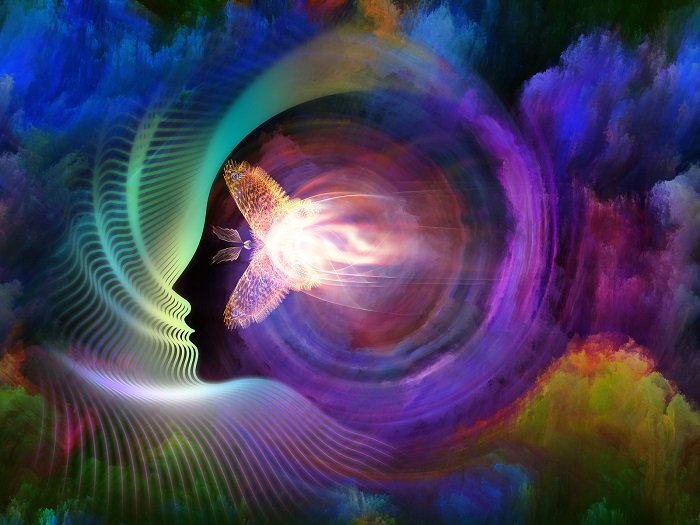
Introduction
“The self” is one of the most frequently used terms whether in professional or common language, but a consensus is still needed as to its meaning. Opinion is growing that it is merely a delusion, a model generated by the brain to help us cope with the world, or just a formal concept in the theory of mind.
I would like to argue the opposite: that is, that the self is a substantial aspect of our being, an underpinning of our sense of self. To do this I will explore the theory of complex systems and its relevance to the conceptualization of the hypothetical self. This is, of course, not the only route towards the conceptualization of the self, there are many other options, particularly from those, who believe that all mental phenomena can be reduced to the functions of the brain. This is a belief I aim to question.
I ought to stress that as this is an exploration of two theoretical concepts – the self and the system, it is unavoidably abstract. In about seven pages I do not have the luxury of space for clinical observations and vignettes. The exception is given in the following paragraph, as I thought it necessary to explain how my clinical practice generated my interest in the validity of the concept of the self.
Practising as a clinical psychologist I became increasingly frustrated by the apparent absence of an accepted unifying notion of an entity behind symptoms. Yet, most symptoms were indicative of a poor integration and lack of cohesiveness in internal processing: detachment from personal feelings, inaccessible memories, cognitive dissonance, doubts as to the validity of personal views and beliefs, broken sense of the self, and more. This was, ultimately linked with the loss of a sense of a personal agency and loss of control combined with a sense of victimization, rather than agency, all leading to poor, even traumatic personal or working relationships. Consequently there appeared to be a diminished capacity to face the world as a cohesive unit, as an autonomous individual with stable mental structures able to withstand external pressures and demands and respond in a sufficiently integrated fashion.
It would therefore seem plausible, for the therapist, to keep in mind as the therapeutic goal, the importance of the restoration or at least improvement of autonomy and underlying structures without dwelling exclusively on following protocols and frameworks of specific therapeutic orientations. The therapist would endeavor to strengthen and expand mental structures, which although eroded, still somehow hold together.
One may ask however, what structures am I talking about? In this respect, I think, subjective impressions and assumptions would have to be replaced by some acceptable objective and plausible paradigm applicable to the rules and constraints of the functions of the whole – perhaps that of a system. After all, we already describe ourselves as a psycho-somatic system, so it is not only interesting but I think imperative, to specify what it means.
The System in General
The interest in systems started around 1943-1953 in biology and ecology, linking to cybernetics, and studying basic principles or models of social behavior. Now it is central to studies of integrative levels of self-organizing complex systems and theories of emergence.
In this article I would like to explore the validity of the paradigm of the self in terms of an individual unit, of the most complex living whole – of the human psychosomatic system.
The System
In general, the essential properties of a system are emerging properties of the whole, which although resulting from the interaction of its parts are more than just a sum of its parts. It is a “sum” not in terms of an addition of similar parts, but in terms of a co-ordination of different or unlike parts of the system. This diversity in unity is one of reasons why the reduction of the emergent property to the original parts would be problematic. By the same token the properties of the “parts” can only be understood within the context of the whole and just one part of the system shouldn’t be seen as generating the whole, or indeed any other part of the system.
The “parts” are not rigid things and the system is not a conglomerate of things, but a flow of ongoing dynamic interactions between different subsystems within a network of non-linear connections and formations of patterns and structures. All ongoing processes are subject to the dynamic of the whole which can also be described as a one dynamic information processing unit.
The system has boundaries and within these it self-regulates towards a purpose, which is primarily its maintenance and survival as an autonomous unit. The system is an open system, which means that there is a constant flow of energy between the system and its environment and consequently it cannot be understood in isolation from its environment. Interconnectedness is the most important aspect of living systems and has an important role in generating the properties of the whole.
It is the flexibility of connections and interconnections which generates new patterns, structures and properties, not just biological or any other rules and laws.
The whole has a causal effect on the rest of the system.
The Human Psychosomatic Unit as a System
In applying the above principles of a system to a human system the first step must be identifying its “parts”. This is not straightforward; it contains room for a considerable controversy. Now I will only list “parts” and introduce them in more detail later.
The whole – and this is clear – is the body, which is conscious and self-conscious.. The role of the body in the system as a whole is, however, less clear and there is still a tendency to reduce the mind to the brain, which, as we have seen, would not be acceptable from the paradigm of a system.
The second “part” is “mental”, psyche, mind, self and this is also controversial. Many still consider mental to be only an attribute of physical, namely the brain. Some will accept there is an ontological difference, but insist on its causal reduction. Here however, I am introducing mental as a distinct “part” of the system able to interact, to connect with the physical, but not being only physical. There are ontological differences, based on the mental processes and states being subjective, conscious and available only to the person who owns them, experiences them, and uses them for complex mental procedures from interpretations, to actions. In this sense mental is clearly different from biological processes, subject to biological laws.
As the systems are open systems, dependent on the flow of energy and matter from the environment, the environment and its stimuli must be considered as a third part of the system.
Following the above, the assumption would be that the properties of the human system as a whole – its conscious awareness, self-consciousness, intentionality, subjectivity and autonomy would emerge from the circularity of mental and physical interconnectedness during the processes of the formation of patterns and structures.
Now the impending issue is understanding the nature of this interconnectedness and also the impact of the emerging properties of the whole on the underlying processes and connections within the system. With this aim in mind I will first say more about each of the “parts”.
The Brain and the Body
The neurological perspective is consistent with the principles of a dynamic coordination of processes within the system: it is a network of connections, clusters of firing neurons communicating in synchrony with clusters of other neurons, brain regions communicating with other, often remote brain regions, constituting a dynamic process of ongoing interactions and the chemical and electrical transmission of information. Communication within the neural subsystem is circular,not linear; neurons are firing in all directions, creating a web- like pattern of organization, running in loops and consequently able to create conditions for feedback, enabling regulation and self – regulation within all aspects of the system. Neurotransmitters, hormones, peptides, the immune system and so on, all play a role in the overall performance of the system as a whole.
One must assume, that these biological transactions also transmit ( or contribute to the transmission of) subjective information, although the nature of this transformation from physical encoding of the process into subjective experience and vice versa is, as yet, unknown (the so called “hard problem”). On MRI scanning a correlation between both levels of processing has been observed, but “correlation” does not automatically imply a causal nature of the relationship and a reduction of mental to neural. Nevertheless, the close connection between mental and physical is undeniable and essential; mental processes are embedded in the brain in the form of memory patterns and schemata, underpinning the continuity of experience, the integration of the new information with the old and interpretations of the new data.
However, while contemplating the role of mental and physical processing within the system, at least as important as understanding how they connect, is understanding their role and functions. And the function of both is to connect and integrate the system into its environment and at the same time – and in response to this – to provide and secure cohesive, integrated and relatively stable internal patterns and structures. And this integrating function, this bridge between the world and the body, I suggest, is the mind. I will address this in more detail later.
The System in the World
Every system is a subsystem of a larger system and therefore it can be understood only within the context of its environment. In other words, as important as the internal unity of the system, is its indissoluble connection with its environment in terms of a continuous flow of physical and mental energy between internal and external.
The interconnectedness of the human psychosomatic system reflects the complexity of the human environment, which has been gradually and substantially modified under the continuous influence of human activity and consequently generates specific kinds of stimuli requiring a specific mental response and generating the emergence of new structures. However, it is important to bear in mind, that this interconnectedness is only possible in an efficient way if the human system is simultaneously capable of generating and maintaining its autonomous position and agency. In other words, although humans are continuously responding to external stimuli by means of internal changes, these changes are not determined by the external, but by already existing internal patterns, memory clusters, and schemata, reflecting cultural, social and material features of human world.
So while the system needs to be open to external input and is prepared for it on both, mental and neurobiological levels it must, at the same time, keep boundaries and maintain its autonomy in order to self-regulate towards its maintenance and survival. Yet the nature of the maintenance and survival of the mental part of the system must differ from that of the physical, in keeping with their ontological differences.
This ontological difference takes effect from the very first contact between the system and incoming data, and it is reflected in the nature of information processing. The assumption here is, that we, as an integrated psychosomatic system, are one complex information processing unit and the information processing has to take place on both mental and biological levels which have to be somehow interconnected, without automatic assumptions about bottom up causality.
To illustrate what I mean, I need to reiterate, very briefly, the difference between symbols (data, or stimuli) and information. Data can be processed outside consciousness, in the form of an algorithm in say, the Turing machine, while information is stimuli which have gained meaning in some context and are, therefore, an aspect of consciousness.
It is therefore difficult to understand J. Searle’s (2004) definition of the Theory of Mind: “The brain is a digital computer, probably a Turing machine. Carries out algorithm by implementing programs and what we call mind is a program or a set of such.”
But from where do the programs emanate? Who needs the answers? Who interprets them?
There seems to be something missing and it seems that Searle fails to realize, that mental processing does not just happen, that it is not just a reaction to stimuli, but is generated by the need of the system to integrate meaningfully with its external circumstances through making sense of the incoming stimuli, of the world and of its own position in it. It is this need that generates the process of turning random data into meaningful information and thus involving consciousness and mental processing. Equally importantly, it is not only the initiation, but also the evaluation of the process that cannot be the result of purely biological processing. The neural system is not intentional and is indifferent to meaning or truth, even if it is capable of brilliant processing of the given task towards the required outcome.
So our contact with external stimuli initiates a complex process and we must distinguish between the merely physical components of information processing and the corresponding mental operations which the psycho-somatic organism is capable of and which are not generated by the rules of algorithm, but by the psychic concerns. This does not mean a reintroduction of any Cartesian notion of the twin substances of mind and body, but the twofold nature of the information processing, engaging the highest levels of the system.
The Mind
It follows from the previous paragraph that the mind cannot be a thing, but a process emerging on the highest levels of the system as a whole. It reflects the nature of an open system as opposed to a closed system: a closed system would be running in circles within the brain, the brain generating and processing its perceptions, asking its own questions and evaluating its own answers. Such a process would be tautological and bereft of meaning. But the mind could be seen as just the opposite – as an interface between the world and the brain. All subsystems within the psychosomatic system integrate towards the emergence of this ultimate aspect of the system as a whole – towards the self-conscious, subjective mind. Consequently, it would be difficult to localize the mind. In fact the whole body seems to be the mind.
All in all, mental processing seems to take place in parallel with biological processing. This was well formulated by Clayton – Davies (2006) “If a connection between the world and a response to it is a formation of mental representations and an overall mental response, then we can assume that mental processes provide criteria by which neural structures are selected for causal roles in the interaction with the environment. It is only by virtue of supervenient mental properties that neural processes become subject to selective pressures of the environment.”
The Emerging Properties of the System as a Whole and their Impact on the Internal Processing
The system and the emergent mind carries the intrinsic properties of *consciousness: unity, intentionality and subjectivity.
Thanks to intentionality we are, at least while awake (notwithstanding altered states of consciousness), continuously engaged with the issues of the world; we are always about something; we are naturally in a state of interconnectedness. It is possible to suspend this state, at least temporarily during say, meditation, but it is difficult and it requires training and practice.
An expression of the mind’s unity is that we perceive the abundance of diverse external stimuli as a unified conscious field and we perceive ourselves and significant others as a continuous part of it. This is not as natural as it might seem, it is a result of a complex mental process, of this “perceptual constancy”. As already suggested, new stimuli or experiences do not enter and are not incorporated as isolated elements, but are carried within as configurations of ordered relationships, forming various cognitive emotional structures, associative networks, memory patterns, schemata, which then act as a grid for new incoming stimuli. Memory, selectivity of attention, imagination and all other processes of the mind become engaged. Most of all, we are on principle rational, capable of abstraction and reasoning and so able to deal also with issues outside our direct experience; we can manipulate issues about the world purely in our heads; we can plan for the future. In these processes emotions play an essential part as they perpetuate the whole system, tuning it and integrating it. The initial screening, therefore, is based on the meaningfulness of stimuli to the categories of the mind, and these, in turn, are derived mainly from our social and cultural environment and imprinted in our mental concepts, symbols and language.
Clearly, we are not just a “bundle of perceptions” as Hume thought. There is not a random, or mechanically associated stream of perceptions, floating thorough our heads like clouds in the sky and dissipating into nothing. There is a unifying factor and this is the mind incorporated in the body. Intentionality and unity of the mind, clearly impact on the nature of the connectivity within the system and on the formation of patterns reflecting the interplay between physical and mental, top down and bottom up connections.
The mind therefore, is not pure consciousness. In fact according to E,R,Kandel (2006) 80 to 90 % of what we do results from memory which is embedded in the unconscious part of the system as a mixture of images, feelings, thoughts. All are subject to modifications, depending on the context of the recall.
Some processes of the mind are based on an automatic system, or emerge from unconsciousness under the pressure of a task or a problem. Yet, some require input from consciousness: new situations with no previous rules; the application of common sense; understanding; judgment forming; artistic appraisal; intuition; insight; bringing together random or seemingly unrelated facts towards a new insight; considerations pro/against; extracting what is relevant from extended information and, where appropriate, choosing the right algorithm for the task in hand and evaluating the result (from Penrose 1989)
There is no doubt, that consciousness flows on the stream of unconscious processes, some close by, some nicely filed in long- term memory slots. Some unconscious memory clusters or schemata, are almost out of reach, as some data carry conflicting, inconsistent information; some are incompatible with the already stored information or with the existing self-image. Some that contain emotionally painful experiences are processed and stored differently under the selective role of consciousness (underpinned by the existing networks), making it difficult for certain types of information to be accessed.
It is clearly the whole system and the unity of its conscious and unconscious processes and states that exerts a self-regulatory influence, sometimes facilitating new insights, sometimes protecting its sense of self, its integrity, its sense of agency, its autonomy and survival, utilizing various tricks, distortions, suppressions, or modifications in storing or retrieving existing memory. These defensive maneuvers help but if excessive they could act to the detriment of the whole system, weakening its cohesiveness and integrity.
Subjectivity
The third intrinsic attribute of consciousness, which makes the mental states and processes ontologically irreducible, is its subjectivity, which together with unity and intentionality generates a sense of self in that we perceive ourselves as one continuous self during the passage of time and during the accumulation of diverse experiences. We are also aware of ourselves as distinct from the significant other and we can explore ourselves as if it were from outside, capable of self-observation, self-explanation, distancing. We have “an existential intuition”- that “I am this and it is enduring” (R.Tallis – 2013 address at the RIP). Our all-important emotional intelligence is born out of our sense of self. We have a “first person perspective” which means that we are the only ones able to access directly our thoughts, feelings, intentions and our unique, personal mind set. Consequently our mental states, conscious processes and actions are not determined (although influenced) by objective circumstances, but rather by our subjective decisions, choices, intentions, even fleeting fancies, which we could also modify or reverse.
So within the parameters of our conscious existence, we experience ourselves as rational, autonomous, independent, active agents capable of decisions based on our own mindsets and awareness of our circumstance. In this sense we have free will and a sense of an autonomous independent agency – a Stahl’s moving force with a purpose.
The Self
As I previously suggested, being a system means that we can only understand who we are and what we are through understanding the context of our existence, through understanding the larger physical, social, cultural world with which we are intimately interconnected. As we have become increasingly differentiated and complex so has the external world, bombarding us with an ever increasing volume of highly complex stimuli which have to be integrated within the already existing patterns and structures of the system while simultaneously forming new patterns or modifying the old.
During this process the system has to self – regulate towards the maintenance of the internal balance and its autonomous, active agency. And this is the important point: the more complex, and demanding the environment, the more this process requires a centralized, individualized, unique subjective response. We have to deal with the world not only from the position of a human in general, but ultimately from the position of our individual selves, our mind sets, beliefs, needs, experiences, intentions – as previously described. This does not mean that we are free of important influences or demands, but rather that we have to adjust creatively and deal with them on the basis of our individual subjective understanding and needs coupled with a sense of responsibility and compassion. We cannot, in principle, fashion our responses by imitating others, or guessing what others would like us to do, or by acting to satisfy others rather than relying on our own judgments while negotiating the demands of the world. We need to have an autonomous, yet flexible self, able to change and develop.
It is this tension between oneself and the complexity of the other that generates the emergence of the self. The self with all its necessary attributes must also include a sufficiently good self- image and confidence in one’s rationality. All these are important for the ability to make independent decisions, choices and take actions while maintaining important social connections and a place in the world. Importantly we need to feel that we deserve to be loved and accepted.
This is the self that only the self itself knows; the self which alone has to survive the trials and tribulations, but also the joys of life. The self while being itself also needs to connect, to belong; the self that could die of isolation. The self that gradually – hopefully- matures and as it does loses or decreases its self-centeredness and selfishness and increases compassion and interest in others. As Shakespeare discerned: “This above all: to thine own self be true”. And we could add Janis Joplin (1943-70): “Don’t compromise yourself. You are all you ‘ve got.”
However, as I have already intimated, this all-important self, our self-awareness, our “first person perspective”, our mind set and our autonomy has its drawbacks: we are locked up in ourselves and even if we are blessed with closeness and the love of others, in crucial moments of our lives, not least when facing death or the pain of a loss, difficult decisions or risky actions, we are ultimately alone. Making choices, decisions and taking necessary risks requires solid foundations. Unfortunately not everyone has been blessed with the necessary conditions, with good enough circumstances during early development, or a necessary level of protection from the enduring adversities of life.
Although the self is resilient and capable of compensatory mechanisms thanks to the involvement of the whole system, it cannot be imposed on too much, or it will start observably breaking down, mentally and/or physically resulting in the subjective experience of loss of ability to cope, feeling stressed, depressed, isolated, anxious, or at its worst, experiencing the dread of losing itself. On the other hand the self can also experience a shift in the opposite direction, a restructuring towards greater integration. A new insight, or a different perspective can suddenly emerge and this can happen at different levels of the system, often accompanied with an intense, and sometimes almost exclusive emotional experience perpetuating the whole system. It might bring about a different experience of self, and, depending on personal beliefs, one might even feel reconnected with one’s soul.
In summary, the self, as consciousness and mind, is an emerging property of the psycho-somatic structure of the system. Its cohesiveness and integration can become experientially even observably damaged or enhanced, and therefore – in my opinion – it is not just a delusion, not even a theoretical model .It is a substantial part of the structure of our psycho-somatic system and plays an essential role in its regulation and self-regulation.
——————————————————————————————————————-
Footnote:
*The issue about the “substance” of the consciousness has not yet been resolved, so in this article when I refer to consciousness, it is strictly in terms of consciousness as an attribute of a human psychosomatic system.
Helen Coufalik received a degree in psychology at the Komenius University in Bratislava, Czechoslovakia (1960). In Czechoslovakia she practised as an assistant lecturer in psychology at the university dedicated to training teachers and later as a clinical psychologist in Psychological – Educational Clinic and in the hospital.
After immigrating to England (1968) I underwent accreditation as a clinical psychologist and worked initially in the dept. for older adults in Hill End Hospital St. Albans, but a majority of my career was spent working full time at Hillingdon Hospital, specializing in psychotherapy in the department for adults and in assessing and diagnosing older adults. She also contributed to the UCL training course. She is a member of the Clinical Division of the BPS and a Chartered Psychologist. Her principal publication is a book “Children with the minimal brain damage” (this would now be an “attentional deficit disorder”). She was both editor and main contributor.




